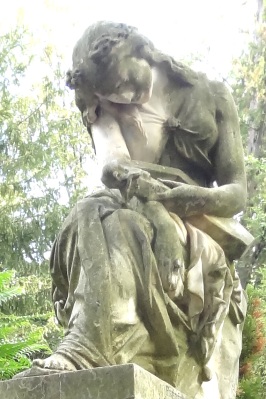
Old Friends in Père Lachaise Cemetery

Marcel Marceau (1923-2007)
I love the story of Marcel Marceau rescuing Jewish children from Nazi-occupied France. He’d dress a group of children in “scout” costumes and lead them in a “nature field trip” until they had safely crossed the border into neutral Switzerland. During their dangerous journey, he kept them quietly entertained with his mime routines.

The signature of “Bip,” Marceau’s clown character:

Guillaume Apollinaire (1880-1918)

On the grave of Guillaume Apollinaire is inscribed his heart calligram:
Mon Coeur pareil à une flamme renversée.
(My heart, like an inverted flame.)

Gertrude Stein (1874-1946)
Alice B. Toklas (1877-1967)
As I was wandering through Père Lachaise last year, I struck up a conversation with a Parisian tour guide who was just finishing with a group. He asked me which graves I wanted to see, and I mentioned a few names. I’m glad I had my good walking shoes on, because he led me on an as-the-crow-flies tour, zigzagging through the cemetery, unerringly arriving each time at the requested burial place. Needless to say, I — who flunked three-dimensional space — gave him a nice tip.
Below, he stands beside the common grave of Gertrude Stein and Alice B. Toklas.

A carafe, that is a blind glass.
A kind in glass and a cousin, a spectacle and nothing strange a single hurt color and an arrangement in a system to pointing. All this and not ordinary, not unordered in not resembling. The difference is spreading.
Gertruce Stein, from Tender Buttons

Théodore Géricault (1791-1824)

As a student, Géricault bucked the prevailing Neoclassical tradition of painting and chose themes with emotional and dramatic intensity. The subject of his monumental Raft of the Medusa still reverberates with its startling originality and pathos.
The painting portrays an actual event: the shipwreck of a naval frigate. Passengers and crew were left by the incompetent captain to die as they drifted helplessly on a raft constructed to save themselves.

Géricault’s large-scale painting in the Louvre overwhelms with the passengers’ brutal suffering and death, and with their waning hope as a ship on the horizon sails on, oblivious to the desperate men waving their shirts.
The subject brings to mind countless disasters at sea, including Africans captured into slavery, who suffered and died during the Middle Passage (of which Géricault would have been aware).
Sculptor Antoine Étex pays tribute to Géricault’s art with his creation of bas-reliefs, which impress by their technical feat of translation from one art form to another.

But the star of the tomb is the gisant or recumbent sculpture of the painter, reclining casually in the manner of Etruscan tomb effigies, wearing a loose-fitting smock and holding palette and brush. The hollow cheekbones and deep-set eyes suggest Géricault’s illness of tuberculosis, which contributed to his early death at the age of 32.

Victor Noir (1848-1870)
What a cruel joke the sculptor played on M. Noir. Maybe he was rooting for Noir’s opponent in the duel that dispatched the man whose reclining likeness has become a fertility charm. It’s reported that Noir’s metallic bulge has been rubbed so often that it’s quite literally wearing away, micron by micron.

Oscar Wilde (1854-1900)
Enough ink and other fluids have been spilled (and lipstick smeared) over Jacob Epstein’s majestic monument to Oscar Wilde.

Jean Carriès (1855-1894)

Sculptor Jean Carriès specialized in miniatures and masks, both of which are featured on his tomb:


A little harder to see are an angel and a pitcher — and between them, a mysterious little eye.

Frédéric Chopin (1810-1849)
Chopin, Polish exile in Paris, is buried at Père Lachaise — all but his heart. He instructed that organ to be removed and buried in his beloved Poland.

At Chopin’s burial at Père Lachaise in 1849, an orchestral arrangement of his Marche funèbre was performed. And for his funeral in the church of La Madeleine, Chopin had requested a performance of the Requiem of Mozart, a favourite composer.

Something that I had forgotten about Chopin — and that is still surprising when I think about it — is his devotion to the music of J. S. Bach. The late Baroque composer’s music had been all but forgotten until Mendelssohn reintroduced it to the world.
On the surface, it’s hard to think of two composers more different. Yet Chopin studied the works of Bach and assigned them to his piano students. Chopin’s 24 Preludes for piano, written in all the major and minor keys, were inspired in part by Bach’s Well-Tempered Clavier.
On a more stylistic level, Chopin can be contrapuntal — not only because he wrote a handful of fugues — and Bach can be bel canto to rival Bellini. I always thought of Bach as something of a Romantic, in a clockwork universe kind of way . . .
Chopin’s heart being in Poland, literally and figuratively, did Chopin find Bach’s polonaises among his dance movements?
Georges-Eugène Haussmann (1809-1891)
Haussmann, responsible for Paris’ architectural daily bread of wrought-iron balconies and Mansard roofs, is buried in a Neoclassical crypt:

Art Nouveau cutouts decorate the nicely patinated door.

Next: So Many Parks . . .
Camille Martin
Pingback: Paris Wanderlust: Fountains | Rogue Embryo